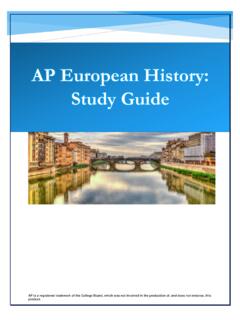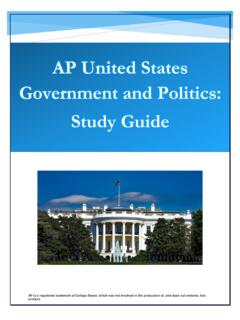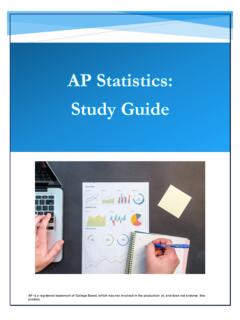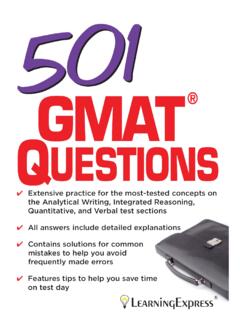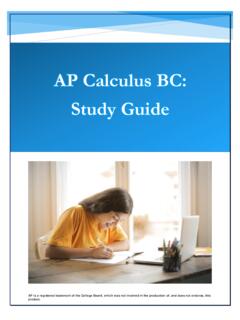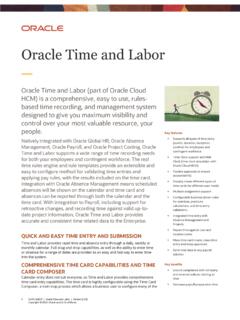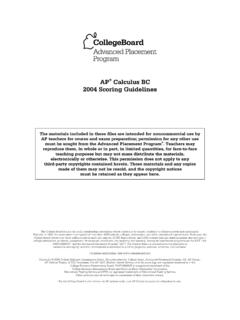Transcription of AP Calculus AB Study Guide - EBSCO Information Services
1 AP Calculus AB: Study Guide AP is a registered trademark of the College Board, which was not involved in the production of, and does not endorse, this product. Key Exam Details The AP Calculus AB exam is a 3-hour and 15-minute, end-of-course test comprised of 45. multiple-choice questions (50% of the exam) and 6 free-response questions (50% of the exam). The exam covers the following course content categories: Limits and Continuity: 10 12% of test questions Differentiation: Definition and Basic Derivative Rules: 10 12% of test questions Differentiation: Composite, Implicit, and Inverse Functions: 9 13% of test questions Contextual Applications of Differentiation: 10 15% of test questions Applying Derivatives to Analyze Functions: 15 18% of test questions Integration and Accumulation of Change: 17 20% of test questions Differential Equations.
2 6 12% of test questions Applications of Integration: 10 15% of test questions This Guide offers an overview of the core tested subjects, along with sample AP multiple-choice questions that are like the questions you'll see on test day. Limits and Continuity Around 10 12% of the questions on your AP Calculus AB exam will feature Limits and Continuity questions. Limits The limit of a function f as x approaches c is L if the value of f can be made arbitrarily close to L. by taking x sufficiently close to c (but not equal to c).
3 If such a value exists, this is denoted lim f ( x) = L . If no such value exists, we say that the limit does not exist, abbreviated DNE. x c Limits can be found using tables, graphs, and algebra. Example Some values of a function are given in the table below. x f(x) 1. Based on these values, it appears that lim f ( x) = , since the values of the function are x 1. growing close to as c approaches 1. Important algebraic techniques for finding limits include factoring and rationalizing radical expressions. Other helpful tools are given by the following properties.
4 Suppose lim f ( x) = L , lim g ( x) = M , lim h( x) = N , and a is any real number. Then, x c x c x L. lim f ( x) + g ( x) = L + M. x c lim f ( x) g ( x) = L M. x c lim af ( x) = aL. x c f ( x) L. lim = , as long as M 0. x c g ( x) M. lim h ( f ( x) ) = N. x c For many common functions, evaluating limits requires nothing more than evaluating the function at the point c (assuming the function is defined at the point). These include polynomial, rational, exponential, logarithmic, and trigonometric functions. Two special limits that are important in Calculus are lim sin x = 1 and lim 1 cos x = 0.
5 X 0 x x 0 x One-Sided Limits Sometimes we are interested in the value that a function f approaches as x approaches c from only a single direction. If the values of f get arbitrarily close to L as x approaches c while taking on values greater than c, we say lim+ f ( x) = L . Similarly, if x is taking on values less than c, we x c write lim f ( x) = L . x c We can now characterize limits by saying that lim f ( x) exists if and only if both lim+ f ( x) and x c x c lim f ( x) exist and have the same value . A limit, then, can fail to exist in a few ways: x c lim f ( x) does not exist x c +.
6 Lim f ( x) does not exist x c . Both of these one-sided limits exist, but have different values 2. Example The function shown has the following limits: lim f ( x) = 1. x 2. lim f ( x) = 1. x 2+. lim f ( x) DNE. x 2. lim f ( x) = 4. x 1 . lim f ( x) = 4. x 1+. lim f ( x) = 4. x 1. Note that f (1) = 3 , but this is irrelevant to the value of the limit. Infinite Limits, Limits at Infinity, and Asymptotes When a function has a vertical asymptote at x = c, the behavior of the function can be described using infinite limits.
7 If the function values increase as they approach the asymptote, we say the limit is , whereas if the values decrease as they approach the asymptote, the limit is - . It is important to realize that these limits do not exist in the same sense that we described earlier;. rather, saying that a limit is is simply a convenient way to describe the behavior of the function approaching the point. We can also extend limits by considering how the function behaves as x . If such a limit exists, it means that the function approaches a horizontal line as x increases or decreases without 3.
8 Bound. In other words, if lim f ( x) = L , then f has a horizontal asymptote y = L. It is possible for x . a function to have two horizontal asymptotes, since it can have different limits as x and x - . Example The function above has vertical asymptotes at x = 2 and x = 3 , and a horizontal asymptote at y = 1 . Looking at the graph, we can determine the following limits: lim f ( x) = . x 2. lim f ( x) = . x 2+. lim f ( x) = . x 3. lim f ( x) = 1. x . The Squeeze Theorem The Squeeze Theorem states that if the graph of a function lies between the graphs of two other functions, and if the two other functions share a limit at a certain point, then the function in between also shares that same limit.
9 More formally, if f ( x) g ( x) h( x) for all x in some interval containing c, and if lim f ( x) = lim h( x) = L , then lim g ( x) = L as well. x c x c x c 4. Example 1 . The sine function satisfies 1 sin x 1 for all real numbers x, so 1 sin 1 is also true x . 1 . for all real numbers x. Multiplying this inequality by x 2 , we obtain x 2 x 2 sin x 2 . Now x . the functions on the left and right of the inequality, x and x , both have limits of 0 as x 0 . 2 2. 1 . Therefore, we can conclude that lim x 2 sin = 0 also.
10 X 0. x . Continuity The function f is said to be continuous at the point x = c if it meets the following criteria: 1. f (c) exists 2. lim f ( x) exists x c 3. lim f ( x) = f (c). x c In other words, the function must have a limit at c, and the limit must be the actual value of the function. Each of the previously mentioned criteria can fail, resulting in a discontinuity at at x = c . Consider the following three graphs: In graph A, the function is not defined at c. In graph B, the function is defined at c, but the limit as x c does not exist due to the one-sided limits being different.
